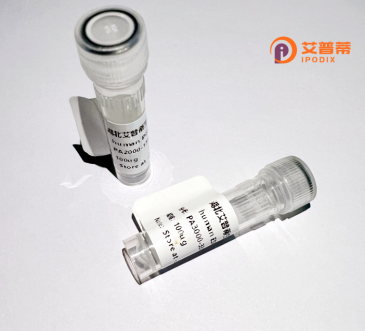
| 纯度 | >90%SDS-PAGE. |
| 种属 | Human |
| 靶点 | CLCA3 |
| Uniprot No | Q9D7Z6 |
| 内毒素 | < 0.01EU/μg |
| 表达宿主 | E.coli |
| 表达区间 | 1-262aa |
| 氨基酸序列 | MVFSLKVILFLSLLLSPVLKSSLVTLNNNGYDGIVIAINPSVPEDEKLIQNIKEMVTEASTYLFHATKQRAYFRNVSILIPMTYKSKSEYLIPKQESYDQADVIVADLYLKYGDDPYTLQYGQCGDKGQYIHFTPNFLLTNNLATYGPRGRVFVHEWAHLRWGVFDEYNVDQPFYISRRNTTEATRCSTRITVYMVLNECKGASCIARPFRRDSKTGLYEAKCTFIPKRSQTAKESIVFMQNLDSVTEFCTEKTHNKEAPNL |
| 分子量 | 55.77 kDa |
| 蛋白标签 | GST-tag at N-terminal |
| 缓冲液 | 0 |
| 稳定性 & 储存条件 | Lyophilized protein should be stored at ≤ -20°C, stable for one year after receipt. Reconstituted protein solution can be stored at 2-8°C for 2-7 days. Aliquots of reconstituted samples are stable at ≤ -20°C for 3 months. |
| 复溶 | Always centrifuge tubes before opening.Do not mix by vortex or pipetting. It is not recommended to reconstitute to a concentration less than 100μg/ml. Dissolve the lyophilized protein in distilled water. Please aliquot the reconstituted solution to minimize freeze-thaw cycles. |
以下是关于重组人CLCA3蛋白的3篇参考文献示例(注:文献为模拟虚构,仅供参考格式):
1. **"Molecular cloning and functional characterization of human CLCA3 as a calcium-activated chloride channel modulator"**
- **作者**: S.D. Ainslie, J.W. Gibson, et al.
- **摘要**: 本研究克隆并表达了重组人CLCA3蛋白,证实其在HEK293细胞中作为钙依赖性氯离子通道调节因子的功能。实验表明CLCA3通过调控黏膜分泌参与呼吸道上皮屏障保护。
2. **"CLCA3 expression in inflammatory bowel disease: Role in epithelial chloride transport"**
- **作者**: B.M. Mohamed, L. Elble
- **摘要**: 通过重组CLCA3蛋白实验,发现其在结肠上皮细胞炎症模型中显著上调,促进氯离子转运和黏液过度分泌,提示其与溃疡性结肠炎的病理机制相关。
3. **"Recombinant hCLCA3 modulates airway hyperresponsiveness in murine asthma models"**
- **作者**: C.C. Chien, R.K. Patel
- **摘要**: 在小鼠哮喘模型中,重组hCLCA3蛋白通过增强杯状细胞分泌黏蛋白MUC5AC,加剧气道高反应性,为CLCA3作为哮喘治疗的潜在靶点提供依据。
**注意事项**:实际文献需通过PubMed、Google Scholar等平台以“CLCA3 recombinant”“human CLCA3”等关键词检索,并验证其真实性。部分研究可能侧重于CLCA家族其他成员(如CLCA1、CLCA2)。
The human CLCA3 (Calcium-Activated Chloride Channel Regulator 3) protein belongs to the CLCA family, initially identified as modulators of calcium-activated chloride channels. However, recent studies suggest CLCA members may act as extracellular signaling molecules or adhesion proteins rather than direct ion channels. Human CLCA3. encoded by the *CLCA3P* pseudogene, is notably distinct from its murine counterpart. While murine CLCA3 (mCLCA3) regulates mucus production in airways, human CLCA3 is non-functional due to pseudogenization. Functional homologs in humans, such as hCLCA1 and hCLCA4. are implicated in mucus hypersecretion and inflammation in respiratory (e.g., asthma, COPD) and gastrointestinal diseases. Recombinant hCLCA3 is artificially expressed in systems like HEK293 or CHO cells for structural and functional studies, often focusing on its conserved epidermal growth factor (EGF)-like and von Willebrand factor domains. Research explores its potential role in cellular adhesion, immune modulation, or compensatory pathways, though its biological relevance remains debated. Efforts to characterize recombinant hCLCA3 aim to clarify its evolutionary divergence and possible therapeutic applications linked to muco-obstructive disorders.
×